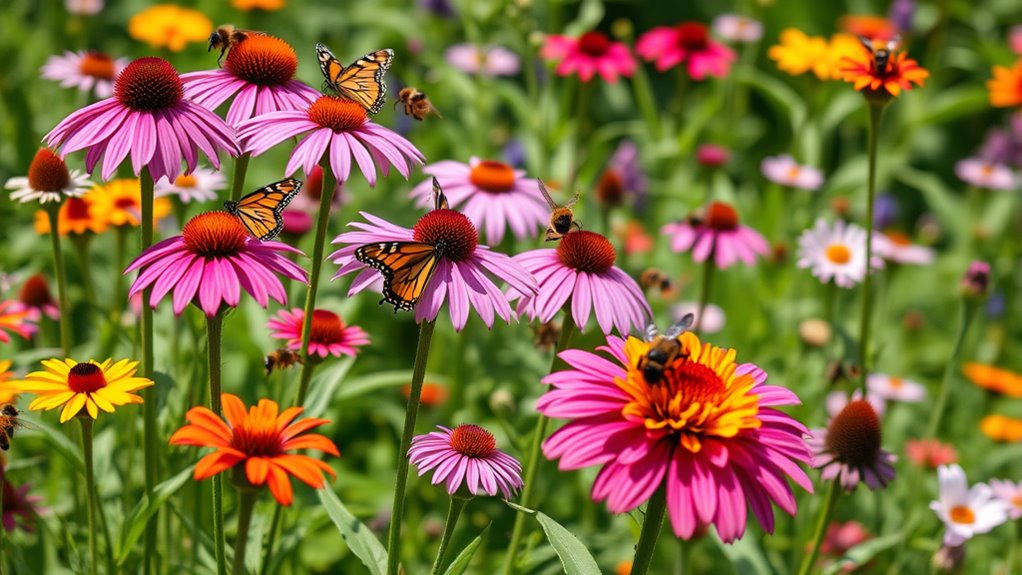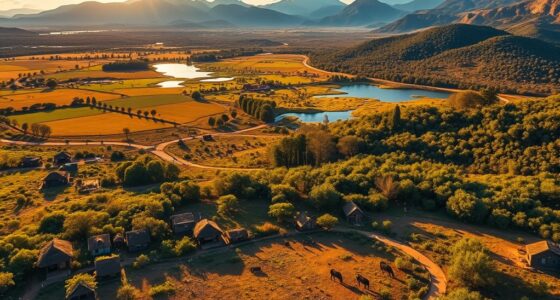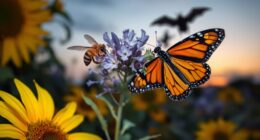To help bees and butterflies in your garden, plant native flowers, shrubs, and trees that provide continuous nectar and pollen throughout the seasons. Avoid using pesticides, especially neonicotinoids, and opt for natural pest control methods instead. Create habitat features like bee hotels and brush piles for shelter, and add colorful, fragrant blooms to attract pollinators. Supporting these small actions can make a big difference—see how you can become a true pollinator hero as you learn more.
Key Takeaways
- Plant a diverse array of native flowers that bloom at different times to provide continuous nectar and pollen sources.
- Avoid using pesticides, especially neonicotinoids, to protect bees and butterflies from harmful chemicals.
- Include shelter options like bee hotels and native shrubs to offer safe resting and breeding habitats.
- Incorporate host plants for caterpillars and larvae to support the full life cycle of pollinators.
- Educate your community about pollinator-friendly practices and advocate for pesticide-free policies.

Pollinators play a essential role in maintaining healthy ecosystems and ensuring the food we enjoy every day. When you want to support bees and butterflies, one of the most effective steps you can take is creating a native plant garden. Native plants are specially adapted to thrive in your local environment, making them the best choice for attracting and sustaining pollinators. By planting a variety of native flowers, shrubs, and trees, you provide necessary food sources—nectar and pollen—that support pollinator populations throughout the growing season. These plants also tend to require less maintenance and water, making them an eco-friendly and sustainable addition to your garden.
Support pollinators by planting native flowers, shrubs, and trees that provide essential nectar and pollen throughout the season.
In addition to choosing native plants, avoiding pesticides is essential to helping pollinators thrive. Many pesticides, especially neonicotinoids, are highly toxic to bees and butterflies, impairing their ability to forage, navigate, and reproduce. When you skip chemical treatments, you create a safer environment where pollinators can feed and reproduce without exposure to harmful substances. Instead of relying on pesticides, consider natural pest control methods like introducing beneficial insects, using physical barriers, or manually removing pests. This approach not only protects pollinators but also promotes a healthier, more balanced garden ecosystem.
Designing your garden with pollinators in mind involves selecting plants that bloom at different times of the year. This guarantees a continuous supply of nectar and pollen, supporting pollinators during their active seasons. Incorporate a mix of colorful, fragrant flowers that attract bees and butterflies, and include host plants that caterpillars and caterpillar larvae need for food and development. Providing shelter is equally important; consider adding bee hotels, native shrubs, or small brush piles where pollinators can rest and hide from predators. Additionally, incorporating native plants can significantly enhance the resilience and attractiveness of your garden for local pollinator species. Furthermore, research shows that modern heat pumps with quieter operation can reduce noise pollution, creating a more peaceful environment for both humans and wildlife, including pollinators. Creating a healthy habitat also involves understanding the importance of pollinator-friendly practices, which can have a positive long-term impact on biodiversity.
You also have a role in educating others about the importance of pollinator conservation. Share your success stories, encourage friends and neighbors to plant native species, and advocate for pesticide-free policies in your community. Small actions, when multiplied across neighborhoods, can greatly bolster local pollinator populations. Remember, your garden isn’t just a space for beauty—it’s a essential habitat that supports these essential creatures. By planting native plants and avoiding pesticides, you create a safe haven that helps pollinators flourish, guaranteeing the health of ecosystems and the future of the food chain.
Frequently Asked Questions
Which Native Plants Attract the Most Pollinators?
Choosing the right native plants depends on understanding pollinator preferences. You should focus on native plant selection that blooms throughout the season, offering nectar and pollen. Plants like milkweed, coneflowers, and bee balm attract the most pollinators. By planting a diverse array tailored to local pollinators, you create a thriving habitat. This boosts pollination, supports local ecosystems, and makes your garden a true pollinator haven.
How Can I Create a Pollinator-Friendly Water Source?
Imagine a gentle splash in your garden—your own pollinator-friendly water source. You can create this with simple water features like shallow dishes filled with stones or a birdbath with fresh water. Use container watering to keep the water clean and inviting, ensuring bees and butterflies find a safe spot to drink and cool off. Keep the water fresh and change it regularly to attract diverse pollinators all season long.
Are Pesticides Safe for Bees and Butterflies?
You might wonder if pesticides are safe for bees and butterflies. Generally, pesticides pose risks to pollinators, so it’s best to avoid them. Instead, use pesticide alternatives like natural pest control methods. Always check the chemical safety of products before applying and opt for organic solutions whenever possible. Protecting pollinators means choosing safer options that won’t harm their essential roles in your garden’s health.
What Time of Year Is Best to Plant for Pollinators?
Who would’ve thought that the best time to plant for pollinators is actually when they need the most help? Seasonal planting is key, and the most suitable timing varies by region, but spring and early summer are prime. You get to support bees and butterflies when they’re most active and searching for nectar. So, plan ahead and plant at the right time to truly be a pollinator hero.
How Do I Identify Different Bee and Butterfly Species in My Garden?
To identify different bee and butterfly species in your garden, start by observing their size, color, and wing patterns. Use field guides specific to your region, which help with species identification. Pay attention to flight behaviors and preferred plants. With practice, you’ll notice subtle differences, making it easier to recognize various pollinators and support their diversity. Keep a journal to track your observations and deepen your understanding.
Conclusion
By creating a welcoming garden, you’re not just beautifying your space—you’re supporting crucial pollinators like bees and butterflies. Some believe planting native flowers alone can save declining populations, but it’s a myth. Real change comes when everyone takes action, providing food and shelter year-round. Your efforts matter more than you think. Together, we can turn small gardens into powerful sanctuaries, proving that even one person’s kindness can make a lasting difference for pollinator survival.










